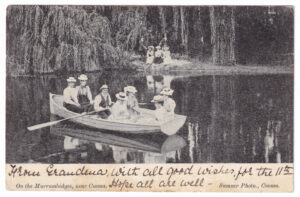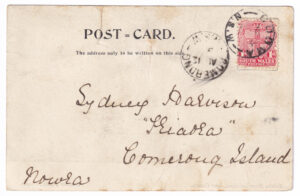[Editor: This postcard, which incorporates a photo of some people in a rowboat on the Murrumbidgee River, is undated; however, it is believed to have been published in the late 19th century or early 20th century, circa 1895-1904.]
[Front of postcard]
[Handwritten text, in italics]
From Grandma, with all good wishes for the 11th
Hope all are well –
On the Murrumbidgee, near Cooma.
[Manufacturer’s information:]
Sumner Photo., Cooma.
[Description: A photograph of six women in a rowboat on the Murrumbidgee River, with one man rowing (on the far shore are three women and two men).]
[Reverse of postcard]
POST = CARD
The address only to be written on this side.
[Addressed to:]
Sydney Harvison
“Kiaora”
Comerong Island
Nowra
Source:
Original document
Editor’s notes:
Dimensions (approximate): 139 mm. (width), 90 mm. (height).
This post card can be dated from 1895 (when privately-manufactured pictorial postcards began to be produced in Australia) to 1904 (in December 1904 the postal authorities allowed postcards to have a divided back, half the area for the address and half for written communication).
See: “1905 postal regulations for postcards (divided and undivided backs)”, Institute of Australian Culture, 18 December 2023
It is possible that this postcard was addressed to Thomas Sydney Harvison or to Walter Sydney Harvison, both of whom later became soldiers with the Australian military.
See: 1) “HARVISON, Walter Sydney”, Virtual War Memorial Australia
2) “HARVISON Walter Sydney : Service Number – 36 : Place of Birth – Sydney NSW : Place of Enlistment – Liverpool NSW : Next of Kin – (Mother) HARVISON E R”, National Archives of Australia
3) “HARVISON, Thomas Sydney”, Virtual War Memorial Australia
4) “HARVISON Thomas Sydney : Service Number – 6037 : Place of Birth – Mackay Qld : Place of Enlistment – Rockhampton Qld : Next of Kin – (Mother) HARVISON Mary Ann”, National Archives of Australia
Comerong Island = an island which was formed during the construction of the Berrys Canal in 1822 (it is located between the Shoalhaven and the Crookhaven rivers, near Nowra on the South Coast of New South Wales)
See: 1) “Comerong Island Nature Reserve”, NSW National Parks and Wildlife Service
2) “Shoalhaven River”, Wikipedia
Cooma = a town in New South Wales, located 114 kilometres (71 miles) south of Canberra
See: “Cooma”, Wikipedia
photo. = (abbreviation) photograph
Updated 18 December 2023


Dear Ed.
When I look at the recipient’s name and address, here is what I see:
Sydney HARVISON
(i.e.: the initial letter of the surname might be an H — or several other possibilities;
and the 3rd letter of the surname looks more like the letter R written in several places lower on that page. Compare the L in the lower word “Island”, for a contrast.)
and where you see a W at the end of the surname, I see instead an N with a large flourish at the end of it.
Next, I read the property name as “Kiaora”. Note here what I said above about the second-last letter seeming to be an R and not an L.
I cannot find a Sydney HARVISON in other online searches; but the WW 1 army records have at least two HARVISONs, with the second forename of Sydney; one of whom seems to indicate that his full name and that of his father were identical, which could be a reason for the family to use his second forename for the younger one.
Hoping that this is of some assistance.
Hi Raymond,
Thank you very much for your input.
That’s a good call on “Harvison” and “Kiaora”.
I tried to find anyone named Harvison mentioned in connection with Comerong Island, but without success.
Have added to the post the details of the two Sydney Harvisons as a possibility.
Regards, Ed